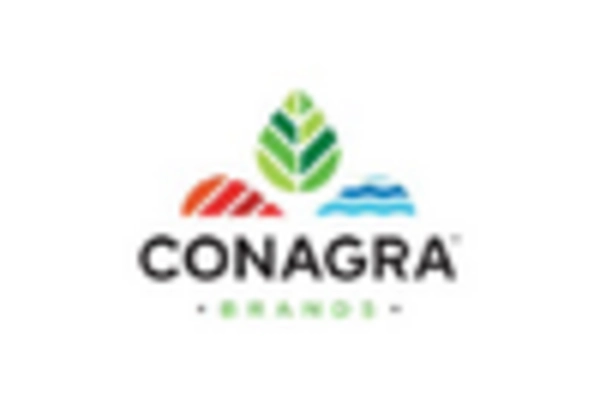Health and Wellness Trends
The US Ready Meals Market is increasingly aligning with health and wellness trends as consumers become more health-conscious. There is a growing demand for meals that are not only convenient but also nutritious. Recent surveys indicate that nearly 70% of consumers are actively seeking healthier meal options, which has prompted manufacturers to reformulate their products. This includes reducing sodium, eliminating artificial preservatives, and incorporating organic ingredients. The rise of health-focused ready meals is evident, with a notable increase in sales of organic and natural ready meal options. As consumers continue to prioritize their health, the US Ready Meals Market is likely to adapt by expanding its offerings to include more wholesome and balanced meal solutions.
Convenience and Time-Saving
The US Ready Meals Market is experiencing a surge in demand driven by the increasing need for convenience among consumers. Busy lifestyles, characterized by long working hours and family commitments, compel individuals to seek quick meal solutions. According to recent data, approximately 60% of American households report that they prefer ready-to-eat meals due to their time-saving attributes. This trend is particularly pronounced among millennials and working professionals who prioritize efficiency in meal preparation. As a result, manufacturers are innovating to offer a diverse range of ready meals that cater to various dietary preferences, including vegetarian and gluten-free options. The convenience factor is likely to continue influencing purchasing decisions, thereby propelling growth in the US Ready Meals Market.
Diverse Consumer Preferences
The US Ready Meals Market is characterized by a diverse array of consumer preferences, which is driving product innovation. With a multicultural population, there is a growing demand for ready meals that reflect various culinary traditions. This has led to the introduction of ethnic and fusion meal options that cater to different taste profiles. Data suggests that meals inspired by Asian, Mediterranean, and Latin cuisines are gaining popularity, appealing to adventurous eaters. Furthermore, the rise of plant-based diets has prompted manufacturers to develop ready meals that cater to vegan and vegetarian consumers. This diversity in consumer preferences is likely to continue influencing product development and marketing strategies within the US Ready Meals Market.
E-Commerce and Online Grocery Shopping
The rise of e-commerce is significantly impacting the US Ready Meals Market, as more consumers turn to online grocery shopping for convenience. Recent statistics indicate that online grocery sales have surged, with ready meals being among the top categories purchased. This shift is driven by the desire for contactless shopping experiences and the convenience of home delivery. Retailers are increasingly investing in their online platforms to enhance user experience and streamline the purchasing process. As e-commerce continues to grow, it is expected to reshape the distribution channels for ready meals, making them more accessible to a broader audience. The integration of technology in shopping experiences may further bolster the US Ready Meals Market.
Technological Advancements in Food Production
Technological advancements are playing a pivotal role in shaping the US Ready Meals Market. Innovations in food processing and preservation techniques have enabled manufacturers to enhance the quality and shelf-life of ready meals. For instance, advancements in vacuum sealing and flash freezing have improved the freshness and taste of products, making them more appealing to consumers. Additionally, the integration of smart packaging technologies allows for better tracking of freshness and nutritional information. As these technologies evolve, they are expected to drive efficiency in production and distribution, ultimately benefiting the US Ready Meals Market. The potential for improved product quality and consumer engagement through technology may lead to increased market penetration.


















Leave a Comment